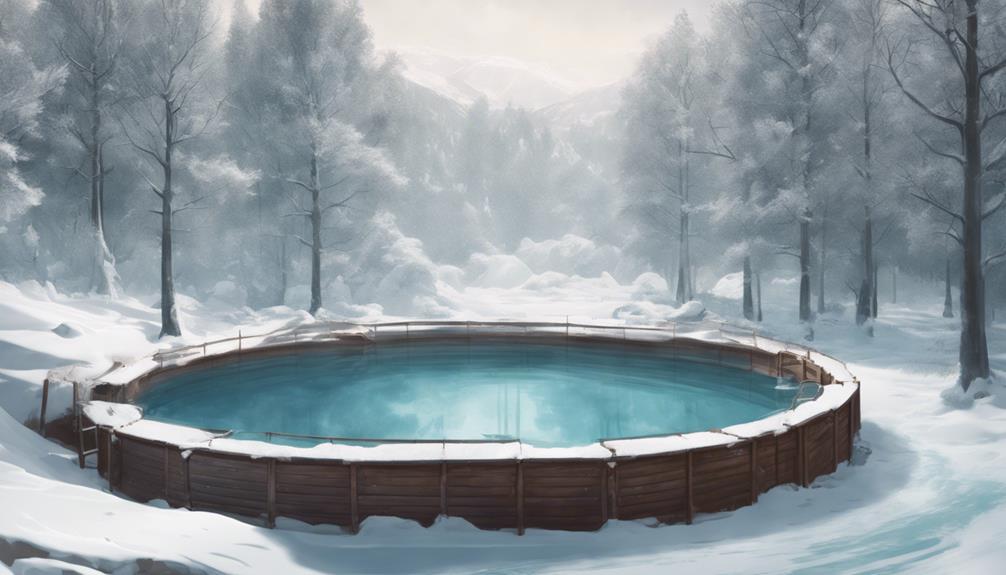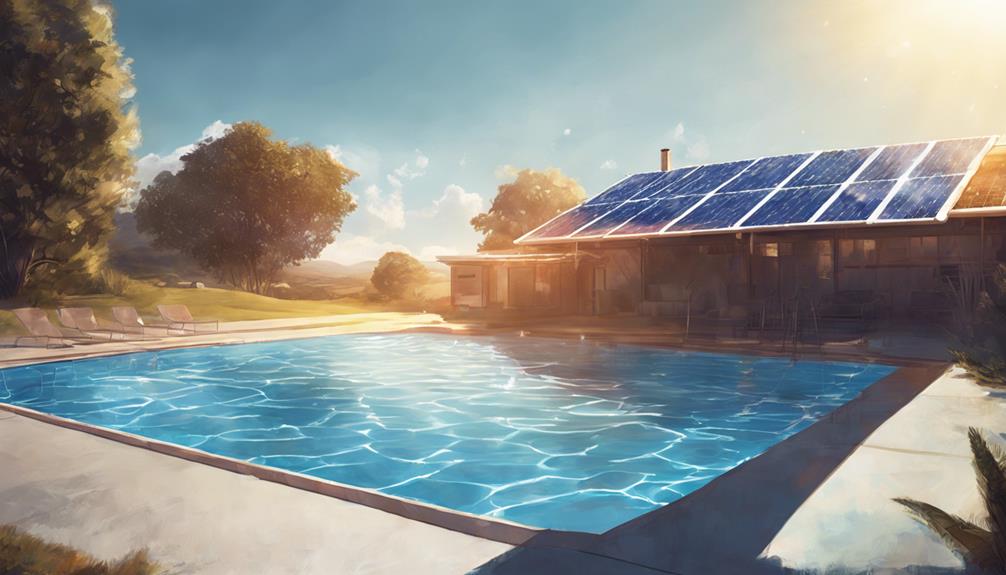To protect your pool from snow, consider using mesh covers for water drainage. It is best to avoid solid covers that may break under the pressure of snow. Do not fully drain in-ground pools and refrain from disturbing ice on the cover. Make sure to maintain the integrity of the cover for maximum protection. You can use pool salt to effectively melt snow and ice. Invest in high-quality products and avoid using sidewalk salt. Use a cover pump to remove any residue and melted snow. Regularly clean the pool to prevent damage and maintain water quality. Efficiently monitor and adjust pool heating systems. Keep water levels adjusted to prevent freezing. Learn effective strategies to safeguard your pool during the winter season.
Key Takeaways
- Use a mesh cover to allow water passage and prevent damage.
- Apply high-quality pool salt to melt snow and ice effectively.
- Clean debris daily, brush walls weekly, and vacuum bi-weekly.
- Maintain heating systems, adjust settings, and use a cover.
- Monitor water levels, lower before winter, and prevent freezing damage.
Pool Cover Protection Strategies
For best snow survival of your pool, implementing effective pool cover protection strategies is essential to shield your pool from winter's harsh conditions. Pool covers serve as the first line of defense against snow, preventing debris and snow from entering the pool and causing damage.
Mesh covers are recommended for their ability to provide protection while allowing water to pass through, reducing the risk of harm from accumulated snow weight.
Solid covers, although capable of holding snow, may break under the pressure when the snow melts. It is vital to avoid draining in-ground pools completely and refrain from disturbing the ice on the pool cover to maintain its integrity throughout the winter season.
Utilizing Pool Salt Effectively
Utilizing pool salt effectively is crucial for maintaining the integrity and functionality of your pool cover during the winter season. Pool salt can assist in melting snow and ice on the cover, preventing excessive buildup that can damage the cover.
When using pool salt, it is important to invest in high-quality products specifically designed for pool maintenance. Avoid using sidewalk salt, as it can contain harmful chemicals that may damage the cover material.
Additionally, using a cover pump to remove residue and melted snow can help keep the cover clear and functioning at its best.
Proper Pool Cleaning Techniques

Implementing effective pool cleaning techniques is essential for maintaining the cleanliness and functionality of your pool throughout the winter season. Regular pool cleaning not only preserves the water quality but also prevents potential damage to the pool's structure. Here are some key pool cleaning techniques to follow:
| Cleaning Technique | Description | Frequency |
|---|---|---|
| Skimming the Surface | Remove debris and leaves from the water | Daily |
| Brushing the Pool Walls | Prevent algae buildup and maintain clarity | Weekly |
| Vacuuming the Pool Bottom | Eliminate dirt and sediment from the floor | Bi-weekly |
Managing Pool Heating Systems
Maintaining top performance and efficiency of pool heating systems is essential for guaranteeing comfortable swimming conditions during the colder months. To effectively manage pool heating systems during winter, consider the following:
- Regular Maintenance:
Schedule routine inspections and maintenance checks to make sure the heating system is operating at its best.
- Temperature Monitoring:
Keep track of the pool water temperature and adjust the heating settings accordingly to sustain a comfortable swimming environment.
- Energy Efficiency:
Implement energy-saving practices such as using a pool cover when the pool is not in use and optimizing the heating system's settings to minimize energy consumption.
Maintaining Water Levels Efficiently

To guarantee proper functioning and longevity of your pool, maintaining appropriate water levels is key in effective water management. Water levels in your pool play a pivotal role in ensuring the structural integrity of the pool during the winter months.
As temperatures drop, it is crucial to adjust the water level based on the type of pool cover you are using. For most pools, lowering the water level by 1-18 inches before winter sets in is recommended. This helps prevent potential damage caused by freezing water and ice expansion.
Consistent water level maintenance throughout the off-season is essential for prime pool care and protection. By following these guidelines, you can safeguard your pool and enjoy a hassle-free winter season.
Frequently Asked Questions
Can I Use a Tarp or Plastic Sheet as a Pool Cover in Snowy Weather?
In snowy weather, using a tarp or plastic sheet as a pool cover is not recommended. Mesh covers are more suitable for snow protection. Solid covers can hold snow, but may break when melted. Proper cover choice is essential for winter pool care.
Is It Necessary to Remove Snow From the Pool Cover Regularly?
According to the National Swimming Pool Foundation, regularly removing snow from your pool cover is necessary to prevent damage. Excessive snow accumulation can lead to cover collapse, causing costly repairs. It's important for maintaining pool integrity during winter.
How Often Should I Check the Pool Cover for Damage or Wear?
Regularly inspect your pool cover for damage or wear to guarantee maximum protection. Check for tears, holes, or weakened areas. Conduct visual checks weekly during heavy snowfall and monthly during milder weather. Prompt repairs or replacements can prevent costly pool damage.
Can I Use a Leaf Blower to Remove Snow From the Pool Cover?
Just as a delicate brush gently sweeps away dust, a leaf blower can delicately remove snow from a pool cover. Use a low setting to avoid damage. Make sure the snow is light and fluffy for effective removal.
Should I Cover My Pool With a Tarp Before Putting on the Pool Cover for Extra Protection?
Covering your pool with a tarp before adding the pool cover may provide extra protection against snow and debris. Confirm the tarp is secured tightly to prevent damage and water accumulation. Consult with a pool maintenance professional for specific recommendations.
How Can I Protect My Pool from Snow and Cold Weather?
To enhance your pool area during snow and cold weather, consider investing in a pool cover specifically designed to handle winter conditions. This will protect your pool from accumulating snow and ice, preventing damage to the surface and equipment. Adding a heater can also help maintain a comfortable temperature.
Conclusion
To wrap up, safeguarding your pool from snow and freezing temperatures is vital for its longevity and functionality. By following the recommended strategies outlined in this guide, you can protect your pool like a sturdy shield against the harsh winter elements.
Remember to:
- Cover your pool
- Use pool salt effectively
- Clean it properly
- Manage the heater
- Maintain the water level
to guarantee a hassle-free winter season. Embrace these proactive measures to keep your pool in top condition.








